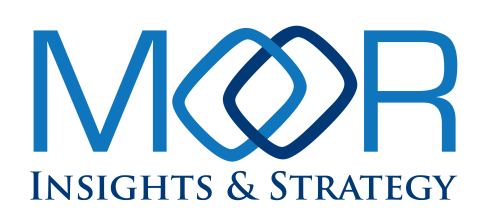
The Moor Insights & Strategy team hopes you had a great week!
The Moor Insights & Strategy team hopes you had a great week!
Last week, Jason Andersen attended the Salesforce AI Now Tour. This week, Matt Kimball will be attending SIGGRAPH virtually. Next week, Will Townsend will be heading to Las Vegas to attend Black Hat.
Last week, our MI&S team published 13 deliverables:
4 Forbes Insight Columns
3 MI&S Research Notes
3 MI&S blog posts
3 Podcasts
Over the last week, the press quoted us with 7 citations. They wanted to hear about AMD, HP, CrowdStrike, Wiz, Google, AI, AI PCs, Semiconductors.
MI&S Quick Insights
In February, Bing began using LLM for chat answers. Now it has combined GenAI and LLMs to create dynamic responses to queries. I tried it, and it provides information with a large variety of options. In fact, I may be tempted to make a permanent switch from my long-time fave—Google. According to Microsoft, it is using a gradual rollout of this change to maintain a focus on accuracy. The company will also be monitoring its impact on publishers. As the one-time owner of an SEO business many years ago, I can tell you there was nothing more discouraging than to see your long-time investment in first-page search results vanish because of an algorithm change by Google. Bing’s intent is to retain traditional search results but provide more clickable links, including references within the AI-generated responses. Some sites will get more clicks, and some will get less, but in the long run, results should equalize.
Senate Democrats are concerned about OpenAI practices. They sent a letter to Sam Altman concerning OpenAI’s safety standards and how whistleblowers have been treated. According to The Washington Post, the letter requested that OpenAI allow the government to test and review the company’s next foundational model. The Senate Democrats also wanted 20% of OpenAI’s compute power allocated to safety research and protocols to thwart malicious actors or foreign adversaries. Whistleblowers have claimed that OpenAI has ignored safety concerns and retaliated against them. True or not, Microsoft and Apple have resigned their OpenAI board seats. One of the whistleblowers said that OpenAI’s existing AI models are not an immediate threat; his concern is the advancement toward more powerful models. Even though existing AI LLM models may seem to provide human-like answers, they are still in the category of “narrow AI.” These AIs cannot reason, and they have limited capability for understanding. On the other hand, artificial general intelligence (AGI), the next level up from narrow AI, is still a theoretical concept. Obtaining AGI is OpenAI’s stated mission. AGI will be able to understand and reason and apply those capabilities to problem-solving. It will also have decision-making capabilities and demonstrate human-like thinking. If AGI can be developed, it will signal a new era in AI, one with great potential as well as significant risks. If it can be developed, it is likely at least seven to 10 years away, based on the best research I’ve seen.
In February, Bing began using LLM for chat answers. Now it has combined GenAI and LLMs to create dynamic responses to queries. I tried it, and it provides information with a large variety of options. In fact, I may be tempted to make a permanent switch from my long-time fave—Google. According to Microsoft, it is using a gradual rollout of this change to maintain a focus on accuracy. The company will also be monitoring its impact on publishers. As the one-time owner of an SEO business many years ago, I can tell you there was nothing more discouraging than to see your long-time investment in first-page search results vanish because of an algorithm change by Google. Bing’s intent is to retain traditional search results but provide more clickable links, including references within the AI-generated responses. Some sites will get more clicks, and some will get less, but in the long run, results should equalize.
Senate Democrats are concerned about OpenAI practices. They sent a letter to Sam Altman concerning OpenAI’s safety standards and how whistleblowers have been treated. According to The Washington Post, the letter requested that OpenAI allow the government to test and review the company’s next foundational model. The Senate Democrats also wanted 20% of OpenAI’s compute power allocated to safety research and protocols to thwart malicious actors or foreign adversaries. Whistleblowers have claimed that OpenAI has ignored safety concerns and retaliated against them. True or not, Microsoft and Apple have resigned their OpenAI board seats. One of the whistleblowers said that OpenAI’s existing AI models are not an immediate threat; his concern is the advancement toward more powerful models. Even though existing AI LLM models may seem to provide human-like answers, they are still in the category of “narrow AI.” These AIs cannot reason, and they have limited capability for understanding. On the other hand, artificial general intelligence (AGI), the next level up from narrow AI, is still a theoretical concept. Obtaining AGI is OpenAI’s stated mission. AGI will be able to understand and reason and apply those capabilities to problem-solving. It will also have decision-making capabilities and demonstrate human-like thinking. If AGI can be developed, it will signal a new era in AI, one with great potential as well as significant risks. If it can be developed, it is likely at least seven to 10 years away, based on the best research I’ve seen.
SAP, Alphabet, and IBM all deliver nice results — It was quite refreshing to hear that tech companies are reporting good results to the investor community. While not everyone overachieved market expectations, there was a lot of talk about meaningful progress and technology adoption. For instance, Alphabet reported a major milestone with Google Cloud having its first quarter of $10 billion in revenue and $1 billion in profit. Meanwhile, SAP and IBM both overachieved analyst expectations. What all of these results had in common was a meaningful impact from GenAI investments. There’s been a lot of AI hype to sort through, so it was good to hear hard facts, for example that 20% of SAP’s deals last quarter had GenAI in them. Google has seen over 2 million developers try out GenAi solutions, and IBM has recorded $2 billion in Gen Ai revenue since starting to track it. While these are still relatively small results compared to the massive investments in AI made over the past 3 years or so, it’s good to see more results than hype.
Salesforce has launched a major worldwide event series called AI NOW — The event is targeted at existing Salesforce admins and developers to showcase new capabilities. However, the star of the show is the upcoming Salesforce Data Cloud product, which is now available for preview in the Salesforce sandbox. Data Cloud is able to integrate and transform diverse data sets (say from S3 or maybe even new partner Workday) into something meaningful for app developers or as a means to augment AI applications and workflows. While GenAI is getting a lot of hype, good data is the cornerstone of its success. Salesforce seems to understand this and to be frank this initiative is a departure from its CRM products. It’s smart of Salesforce to get ahead of the enablement game and build demand now.
Next generation developer use cases — I am starting to get many inquiries from startups that have gone beyond code-assistance use cases for AI and are starting to explore new ways to make developers more productive. Whether it is specialized agents to discover cybersecurity issues during development and before testing, or using GenAI to make developer meetings more efficient, it’s nice to see us move beyond faster coding as a means to drive new efficiencies in the innovation process.
There is a lot of action in the low-code space right now — Yesterday Airtable, an established low-code player, released a new version of its low-code platform, and we have seen others entrants such as Oracle’s APEX and AWS App Studio (which isn’t really low code—I’ll have a lot more on that next week). These latest rounds of innovation all seem to carry a theme of making the barriers to low code even lower. But I will say that this is a tricky market, with different solutions defining who the low-code developers are in different ways. Customers should also evaluate how any low-code platform will tie into their existing IT infrastructure. Low code is great, but it has a selection and implementation process that’s a bit trickier than established pro-code tools.
Salesforce and Workday announced a partnership that aims to transform the employee experience, particularly in onboarding, by leveraging AI to automate tasks and streamline processes. The new AI employee service agent is built on Salesforce’s Agentforce platform and incorporates both Einstein AI from Salesforce and Workday AI.
This AI agent will have access to a shared data foundation, combining Workday’s financial and HR data with Salesforce’s CRM data. This means it should be able to answer questions about payroll, benefits, and company policies and help employees find the right training resources—escalating to a human agent for more complex issues. The partnership will also boost Workday’s integration with Slack, allowing employees to interact with Workday data directly within the messaging platform. The Salesforce and Workday partnership intensifies competition in the AI-powered HCM market, challenging established players such as Microsoft and Oracle.
IBM’s quarterly numbers were strong and demonstrated good growth in a number of critical areas. One of the areas with surprisingly strong performance was Z Systems, with 8% year-over-year improvement. The Z business is fairly cyclical: New generations come out and sales spike, followed by a flattening toward the end of the generation’s life. This 8% growth rate exceeded IBM’s hybrid infrastructure (up 6% YoY) and distributed infrastructure business (up 5% YoY). While the company attributes some of this to AI, I found CEO Arvind Krishna’s comment on transaction processing especially telling. He mentioned that large financial institutions are saving hundreds of millions of dollars by performing transaction processing on-prem (versus in the cloud).
AMD published test results showing the latest EPYC processor outperforming NVIDIA’s Grace Superchip, in some instances by a factor of two. The comparison did not utilize the full memory capabilities and, of course, was made using select benchmarks. In contrast, NVIDIA published benchmarks that showed Grace outperforming EPYC. To round out the picture, third-party high-performance computing labs (University of Buffalo, Stony Brook University) published results that showed Grace outperforming EPYC and Xeon, and coming within striking distance of the formidable Xeon Max.
Who’s right and who’s wrong? The fact is, they are all right. However, CPU performance is highly dependent on a number of factors such as the compilers used, memory configurations, and the like. It is the job of chip companies to make their silicon look better than the competition. This dynamic raises the question: Who should IT organizations trust as a source on matters of performance? For the most unbiased perspectives, look to the independent organizations. Generally speaking, these labs (such as those mentioned in the previous paragraph) are simply pursuing academic interests and nothing more.
One other observation: It is interesting to see the x86 suppliers setting their sights on Arm for CPU performance comparisons. Can there be any stronger endorsement of a product’s viability in the market? (For more on Arm’s growing presence in the datacenter, see my just-published research note.)
What to make of NVIDIA’s announcement to create a China-specific GPU (the B20)? It makes sense that the company would want to find a way to address this market, which represents about 17% of its revenue. The current NVIDIA chip that sells into the China market, the H20, bumps up against performance limitations, so improvements introduced in the Blackwell GPU seem like they would trigger the export restriction. Further, its primary distribution channel (Inspur) is under investigation for selling U.S. technology into the Chinese defense department.
Adobe has updated Illustrator and Photoshop with new AI-powered features from Adobe Firefly. These features aim to streamline creative workflows, enhance customization and precision, and improve designers’ productivity. Some key additions include:
- Illustrator: Generative Shape Fill, Enhanced Text to Pattern, and Style Reference
- Photoshop: Generate Image, enhanced detail in Generative Fill, Selection Brush Tool, and Adjustment Brush Tool
These tools offer faster and more intuitive ways to create and edit designs. Users can generate images from text prompts, create custom patterns, and make precise adjustments to specific areas of an image. With these updates, Adobe has maintained the flexibility and control that professional designers demand. At the same time, simplifying complex processes and offering ways to generate and manipulate content have made these creative tools more accessible and less intimidating for users of all skill levels.
Miro unveiled Intelligent Canvas, its most significant product update since the company’s inception in 2011, positioning it as an AI-powered platform for managing the entire innovation lifecycle. The new features aim to simplify collaboration, provide flexibility, enable workflow planning within the app, and integrate AI assistance across many tasks. The update includes a simplified user interface, intelligent widgets, and composable workflows. Miro’s update enhances its platform with integrations to popular tools, allowing users to create custom workflows for various functions, including sprint planning, road mapping, product planning, team capacity planning, and cloud infrastructure optimization. Miro’s updates should better position it against other visual collaboration platforms such as Lucidchart and Lucidspark, as well as FigJam, Figma’s online whiteboard tool.
This week, IBM, SAP, and Alphabet released earnings reports. Each reported strong performance, with a focus on AI, cloud, data, and partnerships.
IBM touted its AI and cloud strategy, particularly as it relates to the watsonx platform. The company saw growth across its infrastructure, software, and consulting businesses, with the strongest growth coming in the software segment. IBM chairman and CEO Arvind Krishna emphasized one of my own most strongly held views when he said, “The last 12 months of AI pilots has made it clear that sustained value from AI requires truly leveraging enterprise data.”SAP is seeing rapid growth in its Cloud ERP segment, driven by ongoing investments in AI and cloud technology. The company has embedded AI into its RISE with SAP program to enhance the cloud migration experience for its ERP users. SAP is focused on capturing a significant portion of the cloud ERP market, which is projected to reach $239 billion by 2032. This growth reflects a broader shift towards cloud-based enterprise solutions; in that context, SAP is positioning itself to meet the increasing demand for flexible and scalable ERP systems.
Alphabet reported success driven by its focus on AI and cloud services through Google Cloud. The company has invested significantly in AI infrastructure to enhance capabilities across its servers, datacenters, and products. While search ads and cloud services showed positive results, YouTube numbers fell short of expectations. Alphabet also announced an additional $5 billion investment in its autonomous vehicle unit, Waymo. This is a longstanding area of research—and real-world development—for Alphabet; these days, there is a lot of activity with tech companies investing in this area, in many cases working closely with auto manufacturers. This could shape the future of transportation—more to come in a future article.
In my most recent briefings with networking infrastructure providers, I am beginning to see a trend emerge in which they are focusing on business outcomes versus products, features, and functions. It is a logical evolution, given the broader industry whitewashing or hype around AI and the reality of portfolios of routers, switches, and access points that are quickly becoming commoditized. The networking solution companies that can identify discrete use cases and provide validated designs and blueprints that can be easily replicated, sold, and deployed can rise above the others and take market share. The timing to do so is excellent right now, especially as customer organizations refresh their IT infrastructures to take advantage of the genuinely transformative capabilities of generative AI.
SAP’s recent DEI report highlights the company’s commitment to product accessibility, ensuring that individuals with disabilities can fully utilize its software and solutions. SAP’s accessibility efforts span its product portfolio and include screen reader compatibility, keyboard navigation, and adjustable color contrast. While some criticize DEI programs, it’s essential to recognize the tangible impact of initiatives like SAP’s. By prioritizing product accessibility, SAP fosters inclusivity and opens the IT world to millions of differently-abled individuals, empowering them to contribute their unique skills and perspectives.
Agricultural robotics startup Monarch Tractor just closed a $133 million series C round, increasing its total funds raised to over $220 million. The company claims this is the largest funding round in the precision farming industry. Automation can potentially end the “chemical era” of farming through precise plowing, planting, fertilization, weeding, and harvesting; for example, frequent tilling and mowing controls weeds without herbicides. John Deere pioneered farming automation in the mid-1990s with significant investments in precision GPS technology and self-driving tractors. Today, the company offers a full line of automated tractors, precision weed sprayers, planters, and other smart implements. Every agricultural equipment company now has aggressive automation roadmaps, and startups are disrupting this century-old industry. Here are two examples. Monarch offers an automated, all-electric, driver-optional tractor with machine learning, analytics, and operations management capabilities. Agtonomy takes a system-level approach to providing task-level automation spanning a wide range of equipment; it brings solutions to market through established partners such as Bobcat. The era of agricultural automation has begun.
Bluetooth Low Energy (BLE) and Thread (802.15.4) enable Matter connectivity, so those two radios are now table stakes for low-power connected MCUs. Ceva announced that Alif Semiconductor has licensed and deployed Ceva-Waves BLE and Thread (802.15.4) radio IP in its Balletto family of MCUs. We expect dramatic increases in Matter device shipments over the next two years as Matter becomes a standard “checkbox” feature of every connected consumer product—even for battery-powered devices. Ceva makes it easy for SoC makers to add the required radios.
Apple is once again rumored to be ditching Qualcomm’s 5G modems for its own internally designed 5G modem. It will supposedly start the transition in 2025 with the iPhone SE and iPhone 17 Slim, meaning that the in-house modem will not be for the full lineup yet but rather for lower-volume devices. That said, it seems that Apple will have to continue to use Qualcomm modems in the iPhone 17, meaning that there will likely be direct comparisons that could highlight gaps in performance or power usage. That said, Apple is building a modem to control costs and integration, and I expect that we’ll eventually see Apple’s 5G modem evolve to be attached to every device Apple makes.
AST SpaceMobile has completed the assembly and testing of its five commercial satellites, which are expected to be launched in the next few months to bring satellite connectivity to multiple 5G operator partners. This should start to move the industry more towards a competitive landscape among AST SpaceMobile, SpaceX, and others.
Intel’s troubles with its 13th Gen and 14th Gen desktop processors, along with AMD’s delayed launch due to quality concerns, have really tarnished the longstanding image that both companies have enjoyed of delivering mostly flawless desktop parts. I believe that AMD will still recover quickly and may benefit from the problems Intel is experiencing with its high-end desktop chips.
OpenAI has announced SearchGPT, a prototype search engine based on its LLM that is designed to compete directly with Google and Perplexity. It will give search results with a direct link to the source material that generated the results.
Soon Windows 11 will be able to add your Android Phone to File Explorer through its ever-growing Phone Link application, which seeks to more seamlessly connect users’ phones with their PCs. I think this is a great thing because I regularly want to transfer files or images from one to the other, and it would be great to have the other device represented as just another folder to access. That said, Phone Link does already make transferring images pretty easy, but files less so.
A new PC vulnerability has been discovered at the secure boot level that was created because engineers didn’t use good security practices with their keys. This has made hundreds of PC models vulnerable to hacking at the secure boot level and could allow attackers to install UEFI malware.
I’ve written several Forbes articles about PsiQuantum, which is unique in that it is not building a number of incrementally sized quantum computers. Rather, its goal has always been to build the first fault-tolerant machine with a million qubits. That plan now has the funds to be realized. The company recently made a deal with the State of Illinois, Cook County, and the City of Chicago to build the first U.S.-based utility-scale, fault-tolerant quantum computer at the former U.S. Steel South Works site. This initiative will involve the University of Illinois, the University of Chicago, and the Argonne and Fermi national labs. The State of Illinois has allocated $500 million to develop Quantum Park, which includes $200 million for a cryogenic plant to support PsiQuantum and other users. PsiQuantum’s Quantum Computer Operations Center will span more than 300,000 square feet, with additional space for future growth. The company also has a parallel project to build a quantum computer in Brisbane, Australia, with support from the Australian government.
Neiman Marcus fell victim to a data breach connected to the recent Snowflake data theft, leaving about 65,000 Neiman Marcus customers impacted. Hackers accessed the Snowflake database between April and May 2024, stealing data that in Neiman Marcus’s case included names, contact details, dates of birth, and gift card numbers. The breach was linked to the “Sp1d3r” threat actor, who put the data up for sale on a hacking forum.
Cloud cybersecurity startup Wiz decided not to be acquired by Google despite a $23 billion offer that would have made it Google’s largest-ever acquisition. It appears Wiz will pursue the IPO route instead. Wiz’s focus is reaching $1 billion in annual recurring revenue and continuing its independent growth. This decision follows a recent funding round that valued the company at $12 billion.
Cloud security provider Wiz recently walked away from a $23 billion acquisition offer from Google in lieu of pursuing an IPO. The move surprised many in the cybersecurity industry, but the recent CrowdStrike fumble may have played a factor. Google would have integrated Wiz into its cloud protection suite, and it is the integration and developer operations miss that has eroded $20 billion in CrowdStrike’s market capitalization in a matter of days.
The NBA has secured a huge new television deal with Amazon Prime Video, through which the streaming giant will pay $1.8 billion annually for 11 years starting with the 2025–26 season to stream a mix of regular-season and playoff games, including some WNBA games, in the U.S. and select international markets. The NBA’s shift towards streaming is part of an evolution in how fans consume sports content, providing greater accessibility, flexibility, and interactivity. For Amazon, pro basketball makes a very desirable addition to a sports lineup that already includes NFL Thursday Night Football, the NHL, top European soccer, NASCAR, pro tennis, and more. Looking at sports broadcasting as a whole, this is yet another development—like AppleTV’s blockbuster MLS deal in 2022—in a trend that is reshaping the present and future of sports broadcasting.
The 2024 Paris Olympics offer a glimpse into how AI is revolutionizing various aspects of sports, serving as real-world use cases that can be applied to other industries. For instance, Intel’s AI-powered 3D Athlete Tracking (3DAT) technology provides real-time insights into athlete performance, potentially informing training and coaching strategies in various fields. Similarly, healthcare providers could repurpose Omega’s Swiss Timing AI, which analyzes athlete movements, and use it for rehabilitation purposes. Meanwhile, the AI-powered system for detecting online abuse towards athletes demonstrates AI’s potential in content moderation, online safety, social listening, and reputation management. To truly capitalize on their Olympic presence, these companies would benefit from effectively communicating how these AI applications translate into practical solutions for businesses across different industries. I look forward to seeing many other technologies in action throughout the 2024 Olympic Games.
The Olympics in Paris are finally here—how fantastic is that! Data and AI will play major roles for fans, athletes, security, sustainability, and broadcasting. The Paris 2024 Olympics leverages AI, augmented reality, and blockchain technology to enhance operations and spectator experiences. Data plays a crucial role in optimizing logistics, ensuring security, and providing real-time insights. AI is used to analyze vast amounts of data to improve efficiency, while blockchain ensures secure data transactions. These technologies will combine to support a unique, innovative, and sustainable event.
AST SpaceMobile took one step closer to its commercial satellite launch with an announcement on July 25th. The company communicated its plan to launch five block 1 Bluebird low-earth-orbit (LEO) satellites in September, subject to final regulatory approval and prevailing weather conditions. The larger antenna array design of the company’s satellites should reduce its long-term constellation footprint relative to Starlink and allay concerns related to space clutter. I also believe that AST’s expansive intellectual property portfolio and collaboration with Nokia gives it a decided advantage in working with mobile network operators, including AT&T and Vodafone, in providing satellite connectivity direct to unmodified smartphones.
Columns Published
- Samsung Unpacks New Foldables And Wearables At Galaxy Unpacked (Anshel Sag)
- 3 Reasons To Start An AI Journey In Your CRM (Jason Andersen)
- CrowdStrike IT Outage Highlights Need For Tighter Operational Updates (Will Townsend)
- MLB All-Star Game Showcases Big-League Technology (Melody Brue)
Research Notes Published
- SAP Releases Q2 FY2024 Results, Reports Double-Digit Revenue Growth (Melody Brue, Patrick Moorhead, Jason Andersen, Robert Kramer)
- Is Arm Neoverse the Datacenter’s Secret Weapon? (Matt Kimball)
- Qualcomm’s AI Workshop Aims to Show Company’s AI Diversity (Anshel Sag)
Blog Posts Published
- IBM Goes For The Grand Slam at Wimbledon with New AI App Features (Melody Brue, Robert Kramer)
- AI Meets Simplicity at Pure Accelerate 2024 (Matt Kimball)
- The Impact of Modern ERP and SCM Systems in Manufacturing (Robert Kramer)
Podcasts Published
Hot Desk Podcast (Melody Brue and Robert Kramer)
The Hot Desk Podcast Ep 31: SAP, IBM, Google Earnings, Salesforce & Workday, AI in CRM, and more
G2 on 5G (Will Townsend and Anshel Sag)
T-Mobile Fiber, AST Satellites, CrowdStrike Outage, Apple 5G, AT&T Earnings, T-Mobile Awards
The Six Five Media (Patrick Moorhead)
Six Five Episode 225: We are Live! Talking IBM, Google, ServiceNow, SAP, Apple & Qualcomm, NVIDIA (Patrick Moorhead)
Citations
AMD / Ryzen 9000 / Patrick Moorhead / Fierce Electronics
Read Patrick Moorhead’s thoughts about AMD’s slight launch delay in their Ryzen 9000 desktop chips.
HP / AI PCs / Anshel Sag / Observer
Anshel Sag’s thoughts on what may be most appealing about AI PCs to businesses and creatives
CrowdStrike / Update Crash / Anshel Sag / Yahoo! Tech
Anshel Sag points out that the recent widespread CrowdStrike tech outage isn’t the first time the company’s CEO George Kurtz has been at the center of a historic IT failure.
CrowdStrike / Update Crash / Patrick Moorhead / Fierce Network
Patrick Moorhead questions the lack of testing prior to deploying the global update.
Wiz / Cloud Security / Will Townsend / Fierce Network
Will Townsend’s thoughts about Wiz walking away from Google’s bid
AI / Patrick Moorhead / TweakTown
Patrick Moorhead says the whole notion of AI coming to a screeching halt is fiction.
Chip stocks / Patrick Moorhead / Yahoo! Finance
Patrick Moorhead discusses the current state of the semiconductor industry.
New Gear or Software We Are Using and Testing
- Samsung Book4 Edge 16” (Anshel Sag)
Events MI&S Plans on Attending In-Person or Virtually (New)
Unless otherwise noted, our analysts will be attending the following events in person.
- SIGGRAPH, July 29-August 1 — virtual (Matt Kimball)
- Qualcomm Snapdragon, July 31-August 1, San Diego (Robert Kramer)
- SIGGRAPH, July 29-August 1 — virtual (Matt Kimball)
- Qualcomm Snapdragon, July 31-August 1, San Diego (Robert Kramer)
- Black Hat, August 3-8, Las Vegas (Will Townsend)
- AI Innovation through AWS Workplace, August 12 — virtual (Jason Andersen)
- Google’s Made By Google Event, August 13, Mountain View, CA (Anshel Sag)
- VMware Explore, August 26-29, Las Vegas (Matt Kimball, Will Townsend)
- GlobalFoundries Analyst Event, August 26-28 (Matt Kimball)
- IFA Berlin, September 6-11, Berlin, Germany (Anshel Sag)
- Oracle Cloud World, September 9-12, Las Vegas (Melody Brue, Robert Kramer)
- Connected Britain, September 11-12, London (Will Townsend)
- Salesforce Dreamforce, September 17-19, San Francisco (Robert Kramer)
- Intel Innovation, September 23-26 (Matt Kimball)
- Meta Connect, September 25, San Jose (Anshel Sag)
- Verint Engage, September 23-25, Orlando (Melody Brue)
- Infor Annual Summit, September 30-October 2, Las Vegas (Robert Kramer)
- LogicMonitor, Austin, October 2-4 (Robert Kramer)
- Teradata, October 7-10, Los Angeles (Robert Kramer)
- Zoomtopia, San Jose, October 8-9 (Melody Brue)
- MWC Americas, October 8-10, Las Vegas (Will Townsend)
- AdobeMAX, October 14-16, Miami (Melody Brue)
- Lenovo Global Analyst Summit & Tech World, October 14-17, Bellevue, WA (Matt Kimball, Paul Smith-Goodson, Anshel Sag)
- IBM Analyst Summit, October 16-18, New York City (Matt Kimball, Robert Kramer)
- Snapdragon Summit, Maui, October 20-24 (Will Townsend)
- WebexOne, October 21-24, Miami (Melody Brue)
- Cisco Partner Summit LA October 28–30, 2024 (Robert Kramer)
- SAP SuccessConnect, October 28-30 – virtual (Melody Brue)
- GitHub Universe, October 29-30, San Francisco (Jason Andersen)
- 5G Techritory, October 30-31, Riga (Will Townsend)
- Dell Tech Analyst Summit, early November, Austin (Matt Kimball)
- Apptio TBM Conference, November 4-5, San Diego (Jason Andersen)
- IBM, November 6-8, New York City (Paul Smith-Goodson)
- Fyuz, November 11-13, Dublin (Will Townsend)
- Veeam Analyst Summit, November 11-13, Scottsdale, AZ (Robert Kramer)
- Box Analyst Summit, November 12-13, San Francisco (Melody Brue)
- Microsoft Ignite, November 18-22, Chicago (Robert Kramer – virtual, Will Townsend)
- Super Computing, November 18-22, Atlanta (Matt Kimball)
- AWS re:Invent, December 2-6, Las Vegas, (Robert Kramer, Will Townsend, Jason Andersen, Paul Smith-Goodson)
Subscribe
Want to talk to the team? Get in touch here!






























































































